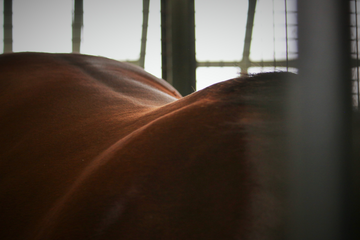Cold Backed: What is it?
When you think of the temperature on the horse's back, it probably makes you think of the expression "cold-backed", right? This saying is used to describe a horse showing symptoms of a sensitive or painful back. The symptoms can range from a horse being very mildly distressed due to the girth being tightened, to the pain being so unbearable the horse results to bucking.
These symptoms can linger until the horse has warmed up and stretched sufficiently, so that the muscles are relaxed. A cold-backed horse sometimes “sinks” as the rider mounts, hollowing his back to avoid added pressure. Horses didn’t evolve to carry people on their backs, especially with all the paraphernalia (saddles, tack, bits, etc.) that we use for comfort as riders. Therefore, horses must compensate for the extra weight. This means they can develop sensitive nerve endings or a misalignment in the spine as a result.
Some of the most common causes of developing cold-backs include: pressure from a poorly fitting saddle, aggravation of previous injuries to the back muscle, and/or problems with the horse’s teeth or feet which may cause them to readjust their posture to counteract this discomfort.
Symptoms of Cold-Backed Horses:

- Stiffness through the back during the first few minutes of walk.
- Refusal or reluctance to let you mount from the ground.
- Discomfort when girth is tightened.
- Reactiveness to the saddle, such as dipping or bridging the back when it is placed.
- Soreness and/or sensitivity to grooming over the back.
- Bucking during exercise.
Your vet, saddle fitter, and equine physiotherapist (or Chiropractor) may need to work together to establish the cause and treatment.
How to Quiet the Symptoms:
- Tighten the girth slowly.
- Stretch the horse properly after tacking up (before mounting).
- Walk the horse before you mount or play with them on the ground (i.e. groundwork).
- Allow for ample warmup time under saddle and try different grooming tools (we are a big fan of the Posture Prep, made by Dr. Pat Bona >>> Check it out here).
- Mount from a higher place than the ground such as a fence or mounting block.
The problems associated with a cold-back are usually treatable. Prevention is better than cure, so taking care of your horses back is important and will help them stay fit and healthy.
What else can you do to soothe your horses tense back?
Benefab® offers our patented SmartScrim which features ceramic-infused fabric in addition to 90 medical-grade magnets placed over key acupuncture points for targeted healing of those areas. Each magnet is enclosed in a soft, neoprene cushion for enhanced comfort and sewn into place. Our fabric emits far-infrared rays keeping muscles calm, comfortable, and supple. It is also made of breathable mesh infused with far-infrared emitting minerals. This scrim stimulates recovery time, promotes blood circulation, increases oxygen flow, safely and naturally harmonizes bodily functions—ultimately, reducing pain and stiffness.






















